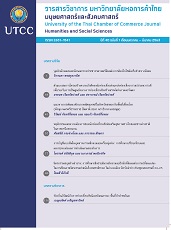Behaviors and Needs of Thai and Foreign Wellness Tourists in Upper North of Thailand
Main Article Content
Abstract
This research aimed to: 1) study the travel behaviors of wellness tourists 2) study tourism needs of wellness tourists in upper north of Thailand and 3) propose guidance in responding to the wellness tourism needs of Thai and foreign tourists in the upper north of Thailand. The samples were 449 Thai tourists and 643 foreign tourist, and questionnaire was used as a tool to collect data. The statistics used in data analysis were frequency, percentage, standard deviation and weighted mean score. The research found that, most of the wellness tourists were in early adulthood. Those wellness tourists found out travel information from online media and from acquaintances. They traveled with family and friends, stayed at hotels and resorts except for Japanese tourists who were mostly elderly rented condominiums for their long-staying. Most of tourists traveled for their own pleasure, aiming to relax and revitalize the body and mind, and to appreciate the beautiful nature and landscape. Activities those attract tourists include: Thai massage, having healthy food and local food, spa, and mineral bath. Most wellness tourists primarily emphasized on safety and quality of food and drink. Wellness tourists needed the provided services with courtesy and humility, also services were supposed to be attentive and enthusiastic, and all the tools and equipment must be cleaned after use.
Article Details
ลิขสิทธิ์ของบทความ
ผลงานที่ได้รับการตีพิมพ์ถือเป็นลิขสิทธิ์ของมหาวิทยาลัยหอการค้าไทย ห้ามมิให้นำเนื้อหา ทัศนะ หรือข้อคิดเห็นใด ๆ ของผลงานไปทำซ้ำ ดัดแปลง หรือเผยแพร่ ไม่ว่าทั้งหมดหรือบางส่วนโดยไม่ได้รับอนุญาตเป็นลายลักษณ์อักษรจากมหาวิทยาลัยหอการค้าไทยก่อน
References
กรวรรณ สังขกร, และศันสนีย์ กระจ่างโฉม. (2561). การศึกษาพฤติกรรมและความต้องการการบริการด้านการท่องเที่ยวของนักท่องเที่ยวเชิงส่งเสริมสุขภาพ (Wellness Tourist) ในพื้นที่ล้านนา 8 จังหวัด. เชียงใหม่: มหาวิทยาลัยเชียงใหม่, สถาบันวิจัยสังคม.
กระทรวงการท่องเที่ยวและกีฬา. (2559). สถิติด้านการท่องเที่ยว ปี 2558. สืบค้นเมื่อ 5 กรกฎาคม 2560, จาก https://www.mots.go.th/more_news.php?cid=479&filename=index
การท่องเที่ยวแห่งประเทศไทย. (2561). จากอดีตถึงปัจจุบัน: ความสัมพันธ์ญี่ปุ่น – ไทย ไปมาหาสู่. TAT Review, 4(4), 45.
จิราวดี รัตนไพฑูรย์ชัย. (2557). ตลาดนักท่องเที่ยวผู้สูงอายุ: โอกาสใหม่ไทย เติบโตรับ AEC. สืบค้นเมื่อ 6 พฤศจิกายน 2562, จาก https://www.itd.or.th/th/ตลาดนักท่องเที่ยวผู้สู/
ฉัตยาพร เสมอใจ. (2550). พฤติกรรมผู้บริโภค. กรุงเทพฯ: ซีเอ็ดยูเคเนชั่น.
ชนิดา ทวีศรี. (2551). การท่องเที่ยวเชิงสุขภาพ (Health Tourism). สืบค้นเมื่อ 19 เมษายน 2560, จาก https://www.l3nr.org/posts/166878
ธานินทร์ ศิลป์จารุ. (2553). การวิจัยและวิเคราะห์ข้อมูลทางสถิติด้วย SPSS (พิมพ์ครั้งที่ 11). กรุงเทพฯ: เอส อาร์ พริ้นติ้ง แมสโปรดักส์.
บุญเลิศ จิตตั้งวัฒนา. (2548). การวางแผนพัฒนาการท่องเที่ยวแบบยั่งยืน. กรุงเทพฯ: การท่องเที่ยวแห่งประเทศไทย, ศูนย์วิชาการ.
Vanida Toonpirom. (2562, 4 มกราคม). Wellness Tourism ยุทธศาสตร์ใหม่การท่องเที่ยว. ผู้จัดการ 360 องศา. สืบค้นจาก https://gotomanager.com/content/wellness-tourism-ยุทธศาสตร์ใหม่การท่องเที่ยว/
ศศิพงศ์ บุญยงค์. (2558, กรกฎาคม). ท่องเที่ยวเชิงสุขภาพ (Health Tourism). Horizon, 3(2), 48-49. สืบค้นจาก https://horizon.sti.or.th/node/5
สำนักงานปลัดกระทรวงการท่องเที่ยวและกีฬา. (2559). การท่องเที่ยวเชิงสุขภาพ (Wellness Tourism). รายงานสภาวะเศรษฐกิจท่องเที่ยว Tourism Economic Review, 3, 30-43.
Adams, T.B. (2003). The power of perceptions: Measuring wellness in a globally acceptable, philosophically consistent way. Retrieved November 6, 2019, from https://www.publishingindia.com/GetBrochure.aspx?query=UERGQnJvY2h1cmVzfC8xMzMxLnBkZnwvMTMzMS5wZGY=
Aktas, A., Aksu, A. A., & Cizel, B. (2007). Destination choice: An important satisfaction analysis. Quality and Quantity, 41(2), 265-273.
Amadeus. (2015). Future traveler tribes 2030: Understanding tomorrow's traveller. Retrieved November 25, 2019, from https://amadeus.com/documents/en/retail-travel-agencies/research-report/amadeus-future-traveller-tribes-2030-report.pdf
Cohen, E. (1979). A phenomenology of tourist experiences. Sociology, 13(2), 179-201.
Cronbach, L.J. (1951). Coefficient alpha and the internal structure of tests. Psychometrika, 16(3), 297-334.
Egel, J. F., Blackwell, R. D., & Miniard, P.W. (1993). Consumer behavior (7th ed.). Fort Worth, TX: The Dryden Press.
Global Wellness Institute. (2017). Global wellness economy monitor. Retrieved September 30, 2019, from https://globalwellnessinstitute.org/wp-content/uploads/2018/06/GWI_WellnessEconomyMonitor2017_FINALweb.pdf
Kaplan, S. (1995). The restorative benefits of nature: Toward an integrative framework. Journal of Environmental Psychology, 15(3), 169-182.
Kyle, G., & Chick, G. (2007). The social construction of a sense of place. Leisure Sciences, 29(3), 209-225.
Lehto, X.Y. (2013). Assessing the perceived restorative qualities of vacation destinations. Journal of Travel Research, 52(3), 325-339.
Murphy, P. E., & Enis, B.M. (1986). Classifying products strategically. Journal of Marketing, 50(3), 24-42.
Qu, H., Kim, L. H., & Im, H. H. (2011). A model of destination branding: Integrating the concepts of the branding and destination image. Tourism Management, 32(3), 465-476.
Schiffman, L.G., & Kanuk, L. L. (1994). Consumer behavior (5th ed.). Englewood Cliff, NJ: Prentice-Hall.
Schiffman, L.G., & Kanuk, L. L. (2004). Consumer behavior (8th ed.). Englewood Cliff, NJ: Prentice-Hall.
Smith, M. (2013). Prevention is better than cure! the relationship between wellness and medical approaches to health. Retrieved October 1, 2019, from https://www.slideshare.net/CongresPreventieveWe/melani-smith-keynote-spreker-congres-preventieve-wellness
Tharakan, Y.G. (2012). Development of a health and wellness centre at Manipal - an Introspection. Journal of Hospitality Application and Research, 7(2), 52-66.


